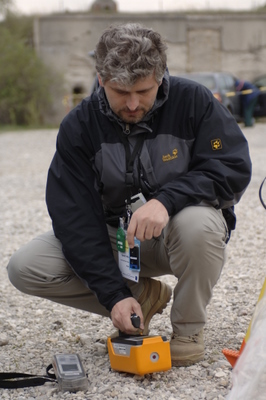
On the trail of Gamma rays: scenes from an international radiation measurement excercise held in Wiener Neustadt, Austria on 16-20 April 2007. During the exercise, the teams used a wide range of equipment and monitoring methods, reflecting the different tasks they faced. Hand-held counters, such as those shown here, were used to determine the presence of a source and locate its position in the field.
(Source:
Dean Calma/IAEA)
Measurement of the energy spectrum and intensity of gamma rays
incident upon a detector for the purpose of establishing the total
amount of the source isotopes in the item measured and the identity
and abundance of the contributing isotopes; this is done by
referencing the measured spectrum to those obtained from standards
in known quantities under well defined geometrical configurations.
The energy resolution of the method depends on the detector used:
when a high resolution detector, such as a Ge detector, is used,
neighboring gamma ray energy lines are usually well separated. High
resolution gamma ray spectrometry is essential for Pu isotopic
analysis and analysis of the spectra of fission products in spent
fuel, while gamma ray spectrometry measurements of U enrichment can
normally be done with lower resolution, e.g. with sodium iodide
(NaI) detectors. There are several types of portable multichannel
analyser used by IAEA inspectors for gamma ray spectrometry
measurements in the field, and the technique has also been adapted
for use in verifying spent fuel in storage pools.